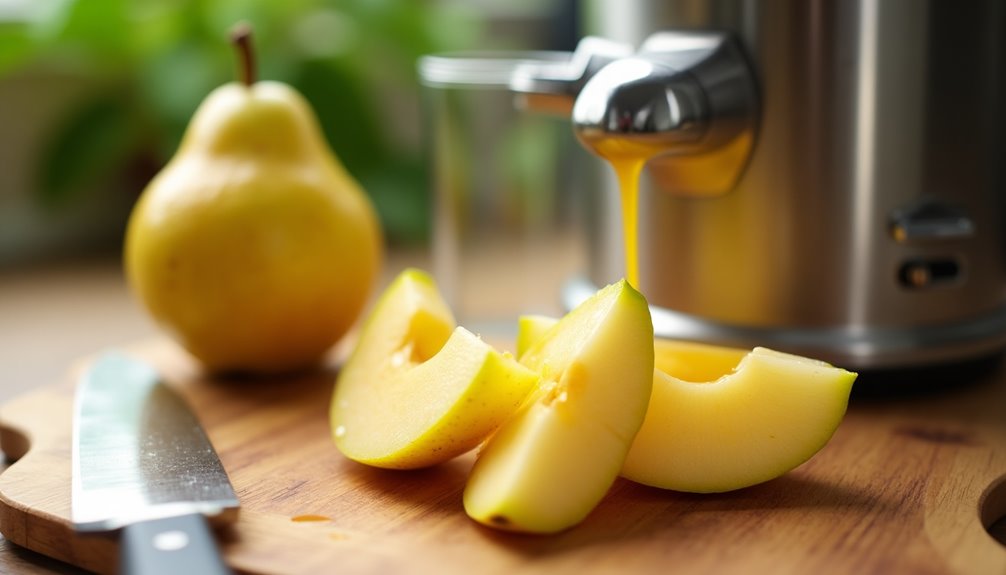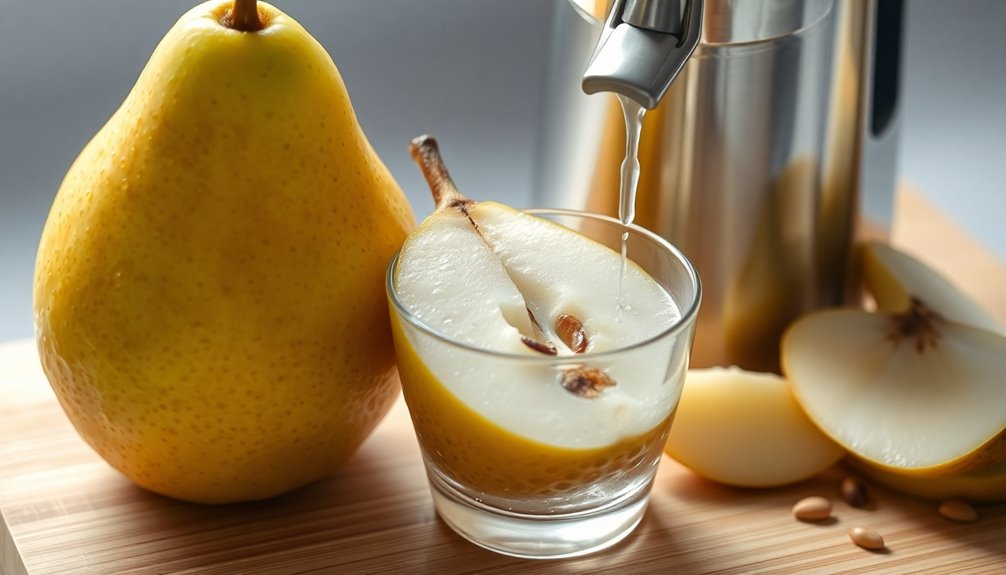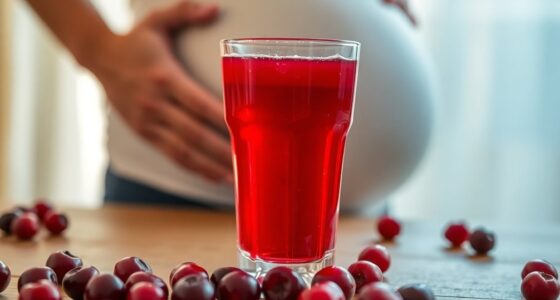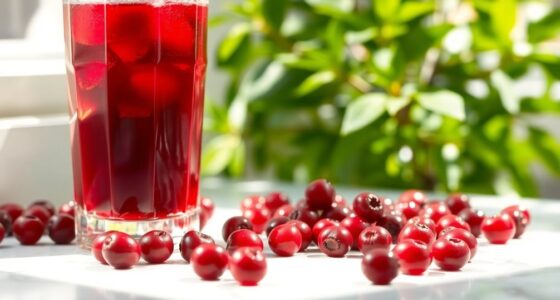To juice a pear, start by choosing ripe Asian pears. Wash and peel them, then remove the core and seeds. Chop the pears into smaller pieces. Blend them with about a cup of chilled water, adjusting to your preferred thickness. For extra flavor, add lemon juice or ginger. Strain the juice for a smooth consistency and enjoy immediately for the best taste and nutrients. Discover more tips and tricks to elevate your pear juicing experience! For those looking to expand their juicing repertoire, learning how to juice a papaya can be a delightful addition. Just like with pears, start by selecting ripe papayas, peeling them, and removing the seeds before cutting them into cubes. Combining papaya juice with your pear juice can create a tropical blend that’s both refreshing and nutrient-rich!
Key Takeaways
- Choose ripe Asian pears, wash, peel, and core them before chopping into smaller pieces for easier blending or juicing.
- Blend chopped pears with one cup of chilled water, adjusting for desired thickness; add lemon juice or ginger for flavor.
- If using a juicer, quarter the peeled pears and process them to extract juice efficiently.
- Strain the blended juice through a mesh strainer for a smooth consistency, and serve immediately for maximum flavor and nutrients.
- Experiment with flavor combinations by adding citrus fruits or fresh herbs to enhance the taste of your pear juice.

Juicing a pear is a delicious way to enjoy its sweet, refreshing flavor. If you're ready to dive into making your own homemade pear juice, you'll find it's a simple process that delivers fantastic results. Start by selecting ripe Asian pears, known for their juiciness. Make sure to wash them thoroughly to remove any dirt or pesticides.
Once they're clean, peel the pears and remove the core and seeds to ensure you have only the good stuff in your juice. When you're ready to blend, chop the pears into smaller pieces. This makes it easier for your blender to work its magic. Grab a blender jar and add the chopped pears along with some chilled water. The amount of water can vary depending on how thick or thin you want your juice, but starting with about one cup should do the trick.
For a little extra kick, you can squeeze in some lemon juice or even throw in a piece of ginger. This optional addition can really enhance the flavor of your delicious pear juice, giving it a refreshing twist. If you prefer using a juicer, the process is even more straightforward. Simply quarter the peeled pears and toss them into the juicer. You'll get a smooth and flavorful juice in no time.
If you're feeling adventurous, consider combining the pears with citrus fruits like oranges or grapefruits. This not only adds a zesty flavor but also boosts the nutritional profile of your fresh pear juice. Once you've blended your pears, it's time to strain the juice. If you went the blender route, pour the mixture through a mesh strainer to remove any pulp.
This step ensures a silky-smooth consistency that's perfect for sipping. You'll be left with a vibrant, delicious pear juice that's not only refreshing but packed with nutrients. Remember, freshly made pear juice is best consumed immediately. The natural sugars and enzymes can oxidize quickly, which means the taste and nutritional benefits can diminish if you let it sit.
You'll want to enjoy your homemade pear juice right away to get the most out of its flavor and health benefits. Next time you're craving something sweet and refreshing, consider juicing pears. It's an easy and fun way to enjoy a healthy treat.
With just a few simple steps, you can have a glass of delightful pear juice that showcases the natural sweetness of this wonderful fruit. So grab some ripe pears, fire up the blender or juicer, and treat yourself to a glass of delicious homemade pear juice. You'll love how quick and satisfying the whole process is, not to mention how refreshing the juice will be!
Frequently Asked Questions
What Is the Best Way to Juice Pears?
To get the best juice from pears, start by choosing ripe, juicy varieties like Asian pears.
You'll want to peel and core them, chopping into smaller pieces for easier processing. If you're using a blender, add some chilled water and consider mixing in lemon juice or ginger for flavor.
With a juicer, quarter the pears for a smooth fit.
Do I Need to Peel Pears Before Juicing?
You don't necessarily need to peel pears before juicing them, especially if they're organic. The skin holds valuable nutrients and adds a nice flavor.
If you're using non-organic pears, it's better to peel them to avoid pesticides. If you want a smoother juice, peeling might be a good choice, particularly if the skin looks tough or damaged.
Just remember to wash the pears thoroughly to get rid of any dirt before you start juicing!
How to Get Juice Out of a Pear?
You won't believe how easy it's to get juice from a pear.
First, pick juicy varieties like Asian pears for the best results. After washing and peeling them, chop the pears into smaller pieces.
If you're using a blender, add a splash of water to help it blend smoothly. Want a flavor boost? Toss in some ginger or lemon juice.
Finally, strain the mixture to remove the pulp, and enjoy your fresh juice!
Can You Put a Whole Pear in a Juicer?
You can't put a whole pear in a juicer without risking damage to the machine. Whole pears might lead to clogging and won't yield the best juice.
It's best to quarter them first, removing the core and seeds to enhance flavor and texture. By preparing your pears this way, you'll ensure a smoother juicing experience and maximize the juice you get.
Conclusion
Juicing a pear is a delightful way to enjoy its sweet, juicy goodness. You might worry about the effort involved, but trust me, it's worth it! The refreshing taste and health benefits far outweigh any hassle. Plus, the vibrant juice can brighten your day and inspire creativity in your recipes. So, grab those ripe pears and start juicing! You'll not only nourish your body but also treat your taste buds to an unforgettable experience. Enjoy every sip!
Cindy thoroughly researches juicing trends, techniques, and recipes to provide readers with practical advice and inspiration. Her writing style is accessible, engaging, and designed to make complex concepts easy to understand. Cindy’s dedication to promoting the advantages of juicing shines through her work, empowering readers to make positive changes in their lives through the simple act of juicing.

















